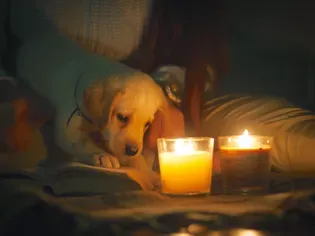What to Do if Your Dog Eats a Candle
Updated on 04/26/24

Oh, Candlemas! What to Do if Your Dog Eats a Candle
Our beloved canine companions, with their curious noses and insatiable appetites, can sometimes find themselves in precarious situations. One such predicament is the accidental ingestion of a candle. While most candles are not inherently toxic to dogs, the components they contain can pose significant health risks.
Understanding the potential dangers and knowing how to respond swiftly can make all the difference in protecting your furry friend. In this comprehensive guide, we will delve into the ramifications of candle ingestion and provide actionable steps to ensure your dog's well-being.
Decoding the Candle's Composition: A Chemical Inventory
Candles, alluring with their aromatic fragrances and flickering flames, come in a myriad of scents and shapes. However, beneath their aesthetic appeal lies a chemical makeup that varies significantly. The primary components of candles include:
* Paraffin wax: A common and cost-effective wax derived from petroleum, paraffin wax is generally considered non-toxic to dogs in small amounts. However, large quantities can cause gastrointestinal upset.
* Soy wax: A natural and biodegradable alternative to paraffin wax, soy wax is also considered safe for canine consumption in moderation.
* Beeswax: Produced by honeybees, beeswax is safe for dogs when consumed in small quantities. However, it can have a laxative effect in larger amounts.
* Essential oils: Often added for their therapeutic or aromatic properties, essential oils can be highly toxic to dogs. Some common essential oils that pose a significant threat include tea tree oil, citrus oils, and peppermint oil.
* Wicks: Typically made of cotton or paper, wicks can cause intestinal blockage if ingested in large quantities.
* Additives: Some candles contain additional ingredients, such as dyes, fragrances, and glitter. While these additives may not be inherently toxic, they can contribute to gastrointestinal distress.
Assessing the Risk: Weighing the Variables
The severity of a dog's reaction to candle ingestion depends on several factors:
* Type of candle: Candles containing essential oils or other toxic substances pose a greater risk than candles made with non-toxic materials.
* Amount ingested: The quantity of candle consumed is directly proportional to the potential harm it can cause.
* Size of the dog: Smaller dogs are more susceptible to the adverse effects of candle ingestion due to their lower body weight.
* Individual sensitivities: Some dogs may be particularly sensitive to certain candle components, even in small amounts.
Warning Signs: Recognizing the Symptoms
If you suspect your dog has eaten a candle, be on the lookout for these potential symptoms:
* Vomiting
* Diarrhea
* Lethargy
* Drooling
* Abdominal discomfort
* Tremors
* Seizures (in severe cases)
Immediate Action Plan: A Step-by-Step Guide to Response
Upon discovering that your dog has ingested a candle, swift and appropriate action is crucial:
1. Remove the Candle: If the candle is still accessible, remove it from your dog's reach.
2. Contact Your Veterinarian: Call your veterinarian immediately for guidance. Provide them with details about the type of candle your dog ate, the amount ingested, and your dog's symptoms.
3. Induce Vomiting (if instructed by your veterinarian): If your veterinarian advises inducing vomiting, they will provide specific instructions. Do not induce vomiting unless instructed to do so.
4. Administer Activated Charcoal (if instructed by your veterinarian): Activated charcoal can help absorb any remaining toxins in your dog's digestive tract.
5. Monitor Your Dog Closely: Observe your dog for any changes in behavior or appearance. Note any symptoms and report them to your veterinarian.
Prevention is Key: Illuminating the Path to Safety
While candle ingestion can be a concerning occurrence, there are proactive measures you can take to minimize the risk:
* Keep Candles Out of Reach: Store candles in a safe location where your dog cannot access them.
* Supervise Candle Use: Never leave a lit candle unattended, especially if your dog is present.
* Choose Pet-Safe Candles: Opt for candles made with non-toxic materials and avoid those containing essential oils.
* Educate Children and Guests: Inform children and guests about the potential dangers of candles for dogs.
Conclusion: Guiding Your Dog's Journey with Care
Candle ingestion in dogs can be a serious matter, but with proper understanding and prompt action, the outcome can be positive. By familiarizing yourself with the risks, symptoms, and appropriate responses, you can ensure your furry companion's safety and well-being. Remember, prevention is always the best medicine, so implement proactive measures to keep your dog away from candles and enjoy the ambiance they bring without worry.
Explore More Pets

Basic Training
Puppy and Baby Introductions

Working Dog Breeds
All About Search and Rescue Dogs

Dog Treatments
Puppy Vaginitis: Signs, Causes and Treatment

Dog Adoption
After More Than 1,200 Days in the Shelter, Coco Goes Home

Basic Training
How to Train Your Puppy to Go on Potty Pads

Hybrid Dog Breeds
The Difference Between a Mutt, Mixed Breed, or Designer Dog?

Dog Treatments
Nail Problems in Dogs

Puppies
7 Reasons Why Two Dogs Are Better Than One